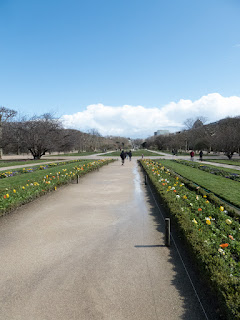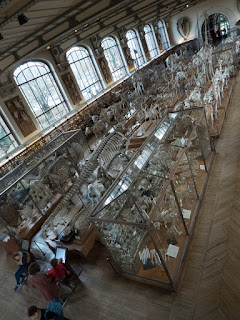Le Musée National d'Histoire Naturelle
A year or so ago I read Elizabeth Kolbert’s opus “The Sixth
Extinction: An Unnatural History.” It was sobering to say the least, dealing
with what is slowly emerging as the sixth time the Earth has undergone a major
reduction in species. Former events ranged in time from 450 to 66 million years
ago and were associated with all kinds of natural phenomena, including comets,
asteroids, giant lava eruptions, sea level variations, and atmosphere changes.
The only one that’s moderately well explained occurred at the Cretaceous-Palogene
border (66 million years ago) and is attributed to the Chicxulub asteroid
impact. Its evidence includes a rather large crater beneath the ocean off the
coast of the Yucatan, and a thick layer of gray clay found around the world
that was formed by the ejecta from the explosion. This event resulted in the
loss of 75% off all species and ended the age of the dinosaurs, paving the way
for the emergence of mammalian species.
The term “extinction” was not well understood until the
middle of the 19th century when Jean Léopold Nicolas Frédéric Cuvier
coined it based on his extensive work with fossils that were collected around
the world, in part by the armies of Napolean. Prior to this, the scientist of
the day had not analyzed the data in a way that led them to the conclusion that
millions of species had existed in the dark past and had disappeared entirely
for some reason or another.
Born in 1769, Cuvier was an extraordinary scientist and work
is considered the foundation of vertebrate paleontology. He also broadly
expanded the Linnaean Taxonomy by not only adding the concept of phyla, but
including the skeletons and fossils of both living and extinct animals.
Interestingly, he also took a strong stand against the nascent concept of
evolution, arguing that his life’s work analyzing skeletal remains did not
support the idea that species change over time.
Where this round-about background is taking us is back to
Kolbert’s book, which covered the life and work of Cuvier in some detail. In
addition to his standing as one of the great scientific minds of all time, he
was also the founder of Le Musée National d’Histoire Naturelle, France’s national
museum devoted to science. When I read the book and discovered this, and that
the very bones Cuvier spent his career analyzing were right there on display
for each and everybody to walk right up to and see in close proximity, I about
kicked myself because we had just returned from our first trip to Paris. Ships
passing in the night and all that. Well, when planning this trip I made sure I
filed a mental note to make sure I didn’t miss a second opportunity.
Yesterday’s unsettled weather continued more violently into
the night. Lots of rain and strong winds, making all the construction
scaffolding and tarps outside our window clang and whip like crazy. We also had
the pleasure of being intermittently bathed in cigarette smoke through our open
bedroom window, no doubt from some husband 2 floors down who is told to smoke
on the window sill in the air shaft when he doesn’t feel like taking the
elevator down to the street. Skunks at home, skulking smokers here. The
universe doesn’t want us to sleep, clearly.
When we got up and got going, the weather seemed a bit less
ugly, at least from our vantage up the two air shafts. Blue sky, sun, and
scudding clouds. We saddled up and headed downstairs and out on to Rue Vaneau where
Mother Nature showed her hand – she’d been sandbagging us. The wind was blowing
hard up the street and pushing rain in our faces. Out with the umbrellas as we
leaned into the tempest. The decision about walking versus Metro was made for
us, before we’d even cleared the first block. Rounding the corner on to Rue de
Sèvres we cleared the 10 meters to the Vaneau Metro station and hobbled down
the stairs buying tickets from the machine and choosing the correct platform.
This being Easter Monday in France, I expected more people but the platform was
empty. The train arrived in perhaps 2 minutes and it was largely empty too, so we
grabbed a couple of jump seats by the door and settled in for the 5 station
ride.
The weather at our destination was more like that of the
early hours of the day – howling wind, rain coming down in sheets. Of course
that was the moment one of our previously pretty reliable Eddie Bauer umbrellas
decided to blow itself inside-out and throw a rib. I jammed it as best as I could,
like a pigeon with a broken wing, into my messenger bag as we ducked into a
bistro to warm up over a cup of coffee.
Fifteen minutes later and after a bit of Google Mapping the
sun came out, we paid (after being complimented on my perfect pronunciation of “l’addition”
or, “the bill)and we were back out on the street in bright windy sunshine with
nary a rain cloud in sight.
Google Maps had told us it was a 4-minute walk to the
museum, just across Rue de Cuvier. Well, that was sort of true while actually
the place marker for the museum was an outright lie – the museum is a set of
multiple buildings set in a pretty enormous city park called the “Jardin des
Plantes” that includes not only the paleontology museum, but a zoo, many
gardens, an enclosed botanical pavilion, a building devoted to evolution and
another to gems and minerals. Thanks Google Maps! You’ve done it once again. I
suppose I should be grateful that the directions didn’t instruct us to walk
into the Seine. Using a map in the park, we figured out that the place we wanted
was just about as far from where we were standing as could be. Heading off on a
diagonal zig-zag we got there in about 10 minutes. The weather was still
holding and the walk through long lines of emerging spring flowers was very
nice .
Arriving, I was relieved to see that it was open (this being
a holiday) and uncrowded. The security guy who was supposed to be checking bags
weapons and bombs was busy texting so we walked right past and paid and went
in. Stepping up and into the large entry doors, we were immediately struck by
the grandeur of what was in front of us – a giant room, large city library
sized, chock full of skeletons. Big animals on platforms in the middle, little
animals in cases all along both sides. So many bones that the place looked like
a giant white hedgerow. Truly jaw dropping.
As museums go, you wouldn’t say this one was “world class”
since the descriptions were solely in French and there wasn’t a lot of interpretative
information. Rather, this was sort of a museum of a museum - the displays were
largely in the condition in which they were originally produced with ancient
faded description tags, many in Cuvier’s own hand. We strolled down one side
and up another, looking at what caught our eye. From a Fin Whale skeleton that
dominated half the space to a tiny case with 27 individual Hummingbird
skeletons, every imaginable size, shape and species was represented.
We spent about an hour among the bones, picking out some
favorites. Things like a display showing the evolution of the foot of the horse
and the skeletons of Roseate-billed Spoonbills, one of our Mexico favorites. The
most poignant display, hands down, was that of the Dodo who was represented by
both a skeleton and a reconstruction. Having made the circuit, we went up the
stairs to the second level which was dedicated solely to fossils. Not as dense
as the bone museum, but still impressive with dinosaurs, Pleistocene animals
(such as Mastodon, Ground Sloth, Cave Bear) and even an Archaeopteryx. The
Giant Crocodile was quite amazing, as was the broadly racked Irish Elk. Best
though was the view from the balcony overlooking the skeletons on the floor
below. We decided to pass on the plant fossils featured on the third level and
left the museum, thoroughly satisfied with our visit and happy to see that the
weather was still in our favor. We took an easy stroll out of the park and made
our way back to the Jussieu Metro station. The sky was still pretty nice and
the only gray clouds were to our east, in the direction of the Seine. Tt looked
like we’d be clear for a walk home, but not being able to see what was being
stacked up for us on the western horizon, we decided to take the subway a
second time. More stair work, tickets, my usual feeling that we’re taking the
wrong train, a quick ride back to Vaneau and up into the world where our choice
was validated. It was not sunny and calm in our neighborhood. We ducked into
Carrefour for some groceries and came out into a mild shower that held most of
the way up our street. I was able to finally stop at the ATM and what a great
one it is, allowing you to pick the distribution of the bills. I selected 3-20s
and 4-10s and just as I finished up it started to rain in earnest. Gladly we
were not far from home, just a few more minutes and we were off the street and
making a nice lunch to reward our perseverance.
(click on photos to enlarge)

























Comments